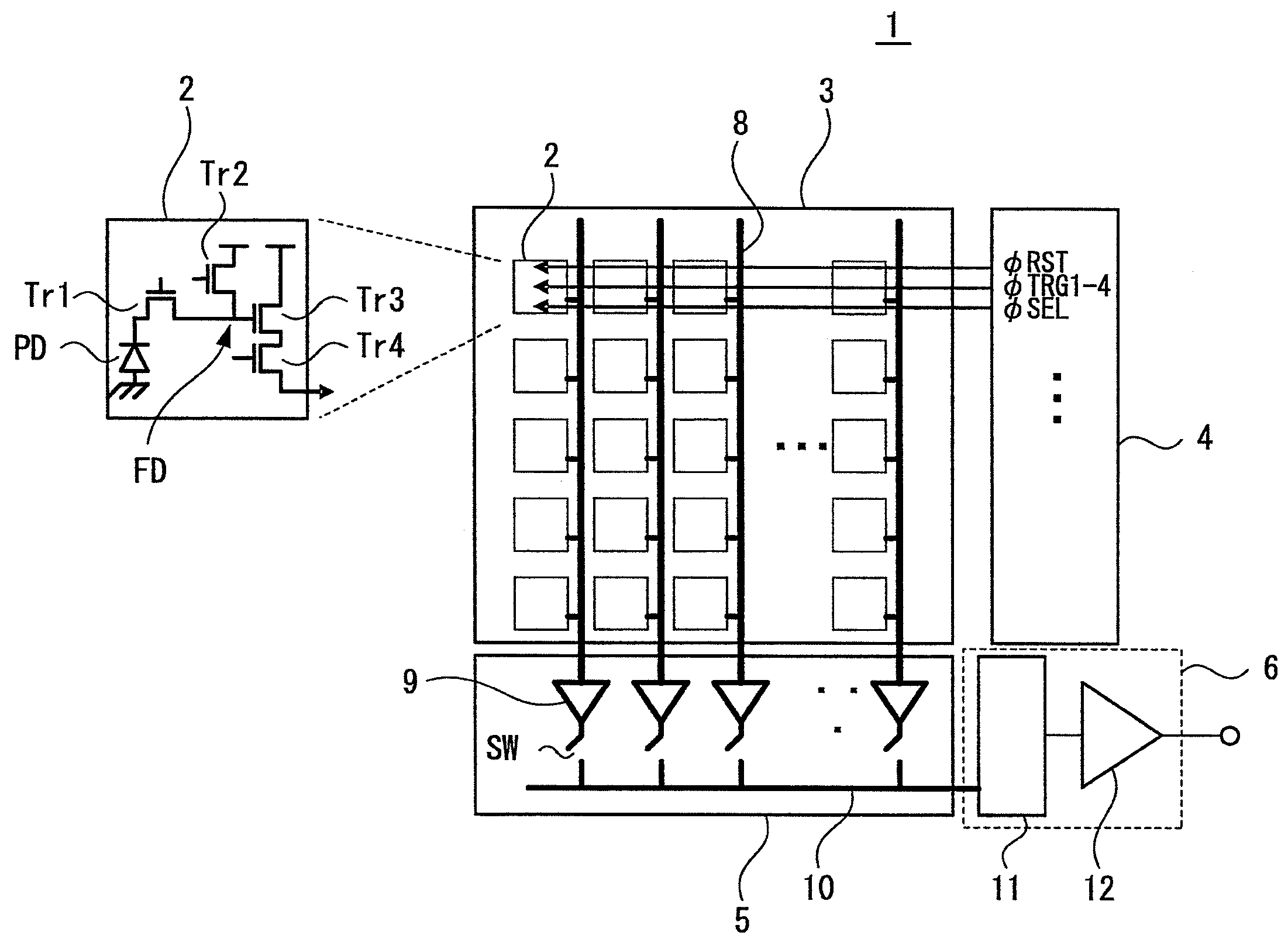Solid-state imaging device and camera
a solid-state imaging and camera technology, applied in the field of solid-state imaging devices and cameras, can solve the problems of deterioration of signal-to-noise ratio, decrease of output per pixel, and degradation of pixel characteristics, so as to improve the range of output signals, increase the amount of saturation charges, and improve the sensitivity of luminosity signals.
- Summary
- Abstract
- Description
- Claims
- Application Information
AI Technical Summary
Benefits of technology
Problems solved by technology
Method used
Image
Examples
first embodiment
[0053]FIG. 4 is a schematic view illustrating the major portion of an imaging section included in the solid-state imaging device, according to the present invention. This drawing illustrates diagrammatically the configuration of pixels in the imaging section, particularly the arrangement configuration of photodiodes serving as photoelectric conversion elements constituting the pixels. In the present embodiment, the photoelectric conversion elements include a group of photodiodes including color photodiodes PD configured to convert light signals in respective wavelength ranges of as red (R), green (G), and blue (B) to electric signals (hereinafter referred to as a red photodiode PDr, a green photodiode PDg, and a blue photodiode PDb, respectively); another photodiode PD configured to convert to further electric signals from light signals in the wavelength range including the entire visible light range and a portion of the infrared light range (hereinafter referred to as a white photo...
fourth embodiment
[0076]Into the structure of the fourth embodiment, the aforementioned inner lens and waveguide structure shown in FIGS. 9 and 10 respectively may also be incorporated.
[0077]FIG. 14 is a drawing generally illustrating a configuration adapted to a solid-state imaging device or CMOS image sensor according to another embodiment of the present invention. The solid-state imaging device of the present embodiment is provided by arranging a plurality of sets in which pixel transistors other than the transfer transistor are shared by a plurality of pixels each provided with photodiodes as photoelectric conversion elements, in this example, four pixels provided with four photodiodes (the set being hereinafter referred to as a sharing pixel).
[0078]The solid-state imaging device 51 according to the present embodiment includes an imaging section 3 (so-called pixel section) in which a plurality of sharing pixels 52 are arranged in a two-dimensional array, and peripheral circuits disposed around th...
fifth embodiment
[0082]In addition, FIGS. 15A, 15B, and 15C are schematic views illustrating the planar configuration of the sharing pixel 52 according to the invention. One set of the sharing pixel 52 according to the present embodiment includes two pixels each vertically and horizontally, four pixels in total. This one set as the sharing pixel 52 corresponds to the aforementioned unit of FIGS. 4, 5A, 5B, and 5C, and the sharing pixel includes one color photodiode PDc out of red, green, and blue color photodiodes, one white photodiode PDw, and two light-shielded diodes Dls (Dls1, Dls2).
[0083]In this embodiment, as shown in FIG. 15A, a common floating diffusion region (FD) 54 is disposed at the center of the structure so as to be shared. The photodiodes PDw, PDc and diodes Dls1, Dls2 are disposed in the two-by-two arrangement, i.e., two of them horizontally and two vertically, so as to hold the common floating diffusion region (FD) 54 in the middle of the structure. Each transfer gate electrode 55 (...
PUM
 Login to View More
Login to View More Abstract
Description
Claims
Application Information
 Login to View More
Login to View More - R&D
- Intellectual Property
- Life Sciences
- Materials
- Tech Scout
- Unparalleled Data Quality
- Higher Quality Content
- 60% Fewer Hallucinations
Browse by: Latest US Patents, China's latest patents, Technical Efficacy Thesaurus, Application Domain, Technology Topic, Popular Technical Reports.
© 2025 PatSnap. All rights reserved.Legal|Privacy policy|Modern Slavery Act Transparency Statement|Sitemap|About US| Contact US: help@patsnap.com



